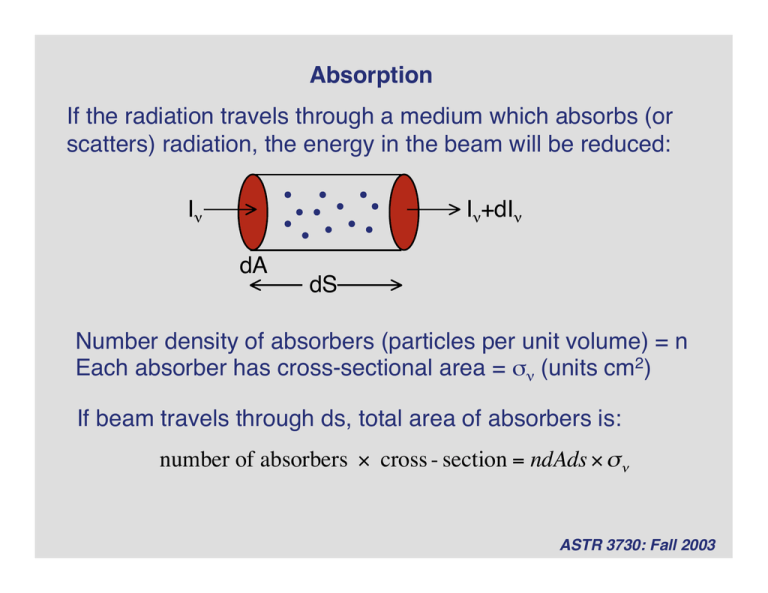N - JILA
advertisement

Absorption If the radiation travels through a medium which absorbs (or scatters) radiation, the energy in the beam will be reduced: In In+dIn dA dS Number density of absorbers (particles per unit volume) = n Each absorber has cross-sectional area = sn (units cm2) If beam travels through ds, total area of absorbers is: number of absorbers ¥ cross - section = ndAds ¥ s n † ASTR 3730: Fall 2003 Fraction of radiation absorbed = fraction of area blocked: dIn ndAdss n == -ns n ds In dA dIn = -ns n In ds ≡ -a n In ds † absorption coefficient (units cm-1) Can also write this in terms of mass: a n ≡ rkn kn is called the mass absorption coefficient or the opacity. Opacity has units of cm2 g-1 (i.e. the cross section of a gram of gas). † ASTR 3730: Fall 2003 Example: Thomson scattering A free electron has a cross section to radiation given by the Thomson value: s nT = 6.7 ¥10-25 cm2 …independent of frequency. The opacity is therefore: † n k n = s n = N As n = 0.4 cm2 g -1 r If the gas is pure hydrogen (protons and electrons only) † (note: really should distinguish between absorption and scattering, but don’t need to worry about that here…) ASTR 3730: Fall 2003 Equation of radiative transfer for pure absorption. Rearrange previous equation: dIn = -a n In ds Different from emission because depends on how much radiation we already have. Integrate to † find how radiation changes along path: s Ú s0 s dIn = - Ú a n ( s¢)ds¢ In s0 s [ln In ] s 0 s = - Ú a n ( s¢)ds¢ s=s0 s s0 s In (s) = In (s0 )e - Ú an ( s¢ )ds¢ s0 ASTR 3730: Fall 2003 e.g. if the absorption coefficient is a constant (example, a uniform density gas of ionized hydrogen): In (Ds) = I0e-an Ds Specific intensity after distance Ds † Initial intensity Radiation exponentially absorbed with distance Radiative transfer equation with both absorption and emission: dIn = -a n In + jn ds absorption emission † ASTR 3730: Fall 2003 Optical depth Look again at general solution for pure absorption: s In (s) = In (s0 )e - Ú an ( s¢ )ds¢ s0 Imagine radiation traveling into a cloud of absorbing gas, exponential defines a scale over which radiation is attenuated. s=s0 When:† s Úa n ( s¢)ds¢ = 1 s0 …intensity will be reduced to 1/e of its original value. † ASTR 3730: Fall 2003 Define optical depth t as: s t n (s) = Úa n (s¢)ds¢ s0 or equivalently dt n = a n ds A medium is optically thick at a frequency n if the optical depth for a typical path through † satisfies: the medium tn ≥ 1 Medium is said to be optically thin if instead: tn < 1 † an optically thin medium is one which a Interpretation: typical photon of frequency n can pass through without being absorbed. ASTR 3730: Fall 2003 † Can rewrite the radiative transfer equation using the optical depth as a measure of `distance’ rather than s: dIn = -a n In + jn ds dIn jn = -In + a n ds an dIn = -In + Sn dt n divide by the absorption coefficient …where Sn = jn / an is the source function. An alternative and sometimes more convenient way to write the equation. † ASTR 3730: Fall 2003

